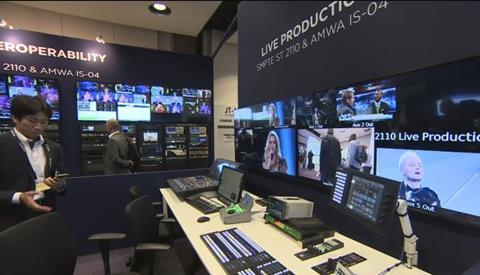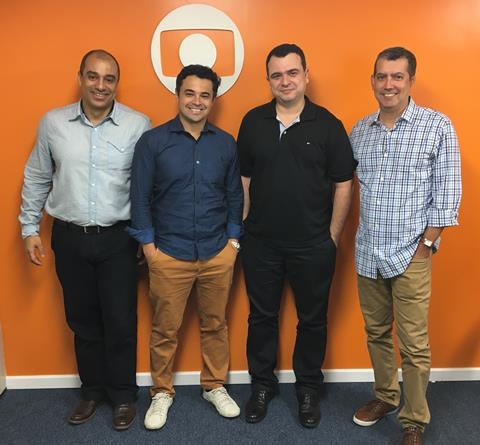What will be the hot topics in 2018? What will lead the debate on IBC365? And what are we likely to be talking about when we all meet in September in Amsterdam? Manufacturers and vendors offer their views.
2018 will be the year we stop focusing on IP. The remarkable work of AIMS and the publication of the SMPTE ST 2110 suite of standards mean that we are well on the way to easy interoperability.

What is important now is to think of how best to use software-centric technology to make creating, managing and delivering content better.
Aperi Chief Executive Joop Janssen also thinks it is time the industry eased back on the IP bandwagon.
“Many vendors are still touting SDI hardware with an IP connector as native-IP,” he says. “More than just linking together workflows with a new connector, IP is an enabler to virtualised workflows, creating more flexible infrastructures that operate as cost effectively as possible.”
Imagine Communications Chief Marketing Officer Glodina Lostanlen agrees. “After years of wrestling with the why and when of transitioning to IP, media companies are now focusing on how to inject their operations with the needed agility to respond to current and future market demands without stranding investment or disrupting operations.”
One of the practical benefits must be the move to virtualisation, centralising processing to maximise productivity for any given hardware investment.
Virtual facilities
Avid Director of Professional Video Product and Segment Marketing Matt Feury goes further, suggesting we are on the verge of the no-computer post house.
“You will just have a centrally located server that will provide instances of Media Composer or any other application,” he says.
“You will no longer need multiple powerful workstations – or even any computers at all – to build out a facility. You could get away with using a client box that decodes the video signal from the server.”
If we are going for virtualisation, should we just leap straight to the cloud?
It seems that concerns about the practical issues of moving big files will remain. Avid’s Ray Thompson says “cloud is still somewhat challenging in post when you are dealing with high resolution content”.
Thompson also predicts that 2018 will see “strong demand for remote production, and the cloud will be an enabler to make that a reality.”
2018 is a big year for sport, and the biggest events – the Winter Olympics in South Korea and the FIFA World Cup in Russia – are at an inconvenient distance for the world’s biggest broadcasters.

The idea of remote production is very attractive, but it is in an engineering head-to-head with another major trend: the boost in quality brought by 4K and high dynamic range.
“A lot of premium sports are now being done in 4K, including Formula One, as well as the UEFA Champions League, Premier League and more,” says SAM Executive Vice President and General Manager, Live Production & Infrastructure, Robert Szabo-Rowe.
“One of the things that makes 4K easier is higher bandwidth ethernet interfaces (25G, 50G and 100G). The problem of trying to get a 4K signal down legacy 10G IP technology has gone away, so the transition to 4k in IP is easy if you pick the right IP solutions.”
Presteigne Broadcast Hire CEO Mike Ransome says that in terms of sport production, the combination of 4k and HDR has “tremendous potential”.
But he warns that one of the key elements of sport production, the use of wireless cameras, becomes a challenge as the resolution goes up.
“Remote capture and transmission of Ultra HD remains hamstrung by latency issues,” he says.
“Broadcasters can cope with some latency, of course, but as resolution increases so does the amount of information that has to be squeezed through the wireless bandwidth python.”
Ransome suggests that current systems cannot fully cope. It seems likely that in 2018, driven by the world of sport, developers of wireless links will find low latency solutions, perhaps based on better codecs to keep the bitrate down.
Gearhouse Broadcast UK Managing Director Ed Tischler makes the point that demand for production, at the highest quality levels, is being driven by the availability of online services to satisfy sports fans.
“To meet the demand for more content, additional activity such as qualifying events are incorporated into the full event coverage, and matches that may not have been televised traditionally are now being captured and made available to viewers directly through online platforms.”
He also says that, when we are talking about Ultra HD, we should remember the audio.
The IBC2017 International Honour for Excellence went to Dolby for 50 years of continuing innovation in sound quality, and visitors were able to listen to some really great Dolby Atmos soundtracks in the IBC Big Screen. The consumer roll-out of Atmos is a likely major trend for 2018.
HDR is another hugely exciting trend, even without increasing the pixel count to 4K (or even 8K in a year or two).
Dan Chung of Atomos is enthusiastic about HDR’s potential. “2018 will be the year that HDR becomes truly mainstream,” he says.
“Consumers can finally see the format easily; practically all the middle and high end televisions offer it. HDR content is coming thick and fast from Netflix and Amazon, with YouTube and Vimeo also getting on the bandwagon. The future is bright – with the addition of some extra dynamic range!”
Geoff Mills, Managing Director of post specialist SGO agrees that 2018 is going to be a big year for HDR.

“We have seen a significant increase globally in finishing HDR broadcast productions, with on-demand service providers like Netflix and Amazon driving the delivery of high-end content to the consumer.
“At the same time, many users have yet to encounter HDR,” he adds.
“They will still need to understand these new principles and workflows, which will no doubt become just another set of deliverables as the demand increases.”
The subject that could generate the most excitement in 2018, though, is machine learning.
We have suddenly reached a place where we have the processing power to do big data analytics. At the same time we have the desire to improve our operational efficiencies, and the business imperative to manage costs.
A paper on big data and machine learning from TV Globo took the IBC2017 Conference Prize. Another conference session was addressed on the ethics of artificial intelligence by Sophia, the disarmingly humanoid robot.

“The biggest question broadcasters need to answer is ‘do we really need machine learning?’,” says Amagi co-founder KA Srinivasan.
“The answer is quite simple. The costs of processing content are increasing exponentially, which means broadcasters now have to consider commercial viability of each region and channel, and sacrifice channels that may not be viable.
“However, users continue to demand more a personalised content experience,” he added. “Machine learning is a possible way out of this stand-off, as it allows broadcasters to create as many channels as possible, without compromising on quality or deploying a high number of people.”
Srini even suggests that the day will soon come when productions can be completely automated, even down to artificially intelligent directors.
This may sound a little far-fetched, but in a recent interview BBC Chief Technology Officer Matthew Postgate revealed that in the summer of 2017 the broadcaster had experimented with AI to replace the director on a comedy panel show. After analysing thousands of programmes, the machine had learnt how to direct the admittedly formulaic genre.
“We are not trying to replace television directors,” Postgate told Broadcast magazine.
“But because we do not have infinite resources, this could open up the number of events we can cover.” Expect machine learning to be making headlines, across the whole industry, in 2018.
Finally, a thought from Mark Harrison, managing director of DPP. “One prediction I will happily make now is that we will see the emergence of a new trend in the audience consumption of video that no-one expected.”
He points to binge viewing as the trend for 2013, the birth of a new aspect ratio in 2015 because consumers started to post videos from their phones which they resolutely held upright, and the wildfire-like spread of live streaming in 2017. However, exactly what this trend will be in 2018 remains to be seen.
























No comments yet